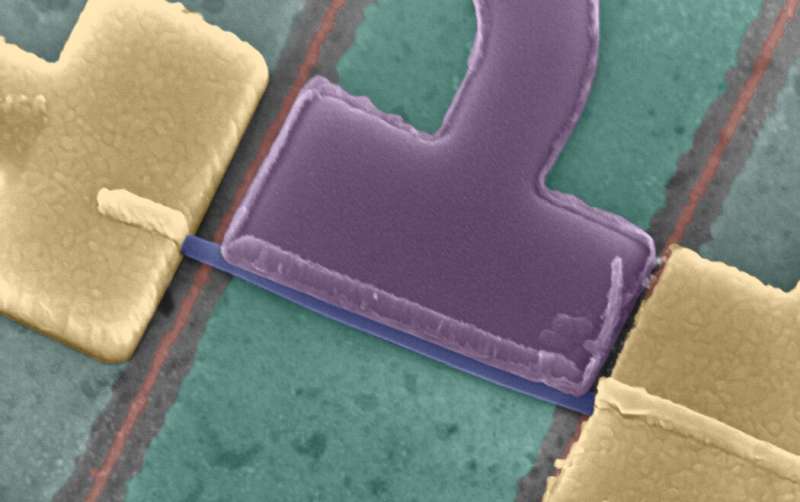May 24, 2019 feature
Study investigates how spin-orbit interaction protects Majorana nanowires

Researchers at Delft University of Technology have recently carried out a study investigating spin-orbit interaction in Majorana nanowires. Their study, published in Physical Review Letters, is the first to clearly show the mechanism that enables the creation of the elusive Majorana particle, which could become the building block of a more stable type of quantum computer.
"Our research is aimed at experimental verification of the theoretically proposed Majorana zero-mode," Jouri Bommer, one of the researchers who carried out the study, told Phys.org via email. "This particle, which is its own antiparticle, is of particular interest, because it is predicted to be useful for developing a topological quantum computer."
Quantum computing is a promising area of computer science that explores the use of quantum-mechanical phenomena and quantum states to store information and solve computational problems. In the future, quantum computers could tackle problems that traditional computing methods are unable to solve, for instance enabling the computational and deterministic design of new drugs and molecules.
Although these computers could have notable advantages, most approaches to quantum computing suffer from a sensitivity to noise that is known as "decoherence." Researchers have hence developed a new type of quantum computer that relies on Majorana particles, which are inherently protected from noise. This "topological" protection requires superconductivity, a phenomenon that allows for dissipation-less electrical current.
"By encoding quantum information into the topological property of Majorana zero modes, the decoherence error/problem can be solved from the fundamental device level," Bommer explained. "This novel system is inherently protected from noise, a problem that plagues alternative approaches to quantum computing. The topological protection from noise is a lot like storing information as a knot in a rope: by slightly shaking the rope, the knot will not come undone."
The creation of Majoranas relies on a magnetic field, which is generally incompatible with superconductivity; a definite requirement of Majoranas. One solution to overcome this limitation is to leverage the interaction of the movement of electrons with their internal "magnets," a phenomenon known as spin-orbit interaction. In the presence of this interaction, a material doesn't feel the magnetic field required by Majoranas as strongly, thus enabling superconductivity.
"Previous research has shown signatures supporting the existence of Majorana zero-modes, although to this day there has been a considerable debate whether these experimental signatures can be mimicked by other physical phenomena," Bommer explained. "In our recent publication, we take a different approach and investigate the prerequisite conditions to create a Majorana zero-mode. To create a Majorana, we need a semiconductor nanowire which intrinsically has spin-orbit interaction, which we couple to a superconducting material to make superconductivity 'leak' into the semiconductor nanowire."
So far, most studies assumed the presence of a spin-orbit interaction in experiments that showed evidence for Majorana modes. Nonetheless, no-one had yet studied the effect of this interaction in superconductor and semiconductor Majorana wires, which is crucial for creating these modes.
"In our study, we revealed this effect and directly measured this spin-orbit interaction and its strength," Bommer said. "We achieved this by studying the effect of magnetic fields in various different directions on the superconductivity."
Typically, magnetic fields suppress superconductivity by closing the superconducting energy gap. The spin-orbit interaction counteracts this suppression when the magnetic field points along specific directions. In their electron transport experiment, therefore, the researchers required a stronger magnetic field to close this gap.
By carrying out theoretical calculations and comparing them with their experimental data, Bommer and his colleagues could estimate the strength of the spin-orbit interaction. This very important parameter was previously unknown in systems for topological quantum computation applications.
"Our observations show that spin-orbit interaction, one of the essential ingredients to create Majorana modes, is present in the system and thus supports the signatures of Majorana modes that have previously have been observed," Bommer explained. "Furthermore, the observed physics by which spin-orbit interaction protects superconductivity is precisely the physics that is ultimately responsible for the expected resilience to noise (i.e. topological protection) that is expected for a topological quantum computer."
The study carried out by Bommer and his colleagues shows that superconductivity and spin-orbit interaction can be present simultaneously, unveiling the mechanisms by which spin-orbit interaction protects superconductivity in Majorana nanowires. Their observations show that more advanced implementations of this material system should also benefit from the spin-orbit protection of quantum information and that the estimated spin-orbit strength provides an important input for the design of quantum computing circuits.
The researchers are now planning further research aimed at finding new experimental signatures for Majorana zero-modes using improved material systems. For instance, they have changed the NbTiN superconductor to a thin aluminum layer, which provides much better superconductivity.
"We are also hunting to observe the Majorana particles on both ends of the wire simultaneously, which is a strong argument to claim the observation of true Majorana modes," Bommer said. "These improvements that we are working on are also required to realize our ambition to create a quantum computer that uses Majorana particles as its building blocks. These near future experiments will not only serve as intermediate steps towards a topological qubit but also show Majorana physics in a more fundamental aspect."
More information: Jouri D. S. Bommer et al. Spin-Orbit Protection of Induced Superconductivity in Majorana Nanowires, Physical Review Letters (2019). DOI: 10.1103/PhysRevLett.122.187702
Journal information: Physical Review Letters
© 2019 Science X Network




















